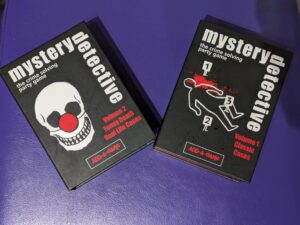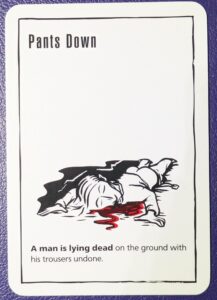Unplugged: Mystery Detective: The Crime Solving Party Game
 Before there were these funny electronic devices that seem to be everywhere, I remember road trips where we had to make our own entertainment. One “20 questions”-style game that we played focused on solving a mystery. Players would be given a somewhat obtuse prompt of a situation and must then figure out what happened and why by asking a series of yes/no questions. Mystery Detective collects many of those mystery puzzles, printing a title and subtle picture/clue on one side with the explanation on the back. It currently comes in two flavors: a collection of 100 “classic” riddles (many of which I remember from my childhood) and one based on “Funny Deaths” – a mix of made-up and real-life cases where things went terribly wrong.
Before there were these funny electronic devices that seem to be everywhere, I remember road trips where we had to make our own entertainment. One “20 questions”-style game that we played focused on solving a mystery. Players would be given a somewhat obtuse prompt of a situation and must then figure out what happened and why by asking a series of yes/no questions. Mystery Detective collects many of those mystery puzzles, printing a title and subtle picture/clue on one side with the explanation on the back. It currently comes in two flavors: a collection of 100 “classic” riddles (many of which I remember from my childhood) and one based on “Funny Deaths” – a mix of made-up and real-life cases where things went terribly wrong.
Mystery Detective (Vol 1 & 2)
Publisher: Add-A-Game
Players: 2-20
Ages: 14+
Time: 15 min
(review copy provided by publisher)
The idea of the game/activity is simple. One player draws a card out of the deck of 100, reads the front aloud, optionally showing the image on the front, and then secretly reads the riddle on the back. Players are then given a short prompt, like “Excessive hurry led a man to a stinky situation.” All players take turns (or shout out popcorn-like) asking yes or no questions. The clue-giver then responds with “yes”, “no”, or “not relevant.” The goal is to figure out what happened AND why. Trying to avoid spoilers, I recall a puzzle from my youth (it very well may be in the box somewhere, I didn’t do ALL the puzzles) that revolved around a dead body – but it turned out to not be a human dead body. It’s this sort of “ah-ha” moment that is the heart of the game. There’s usually one or two details that need to be figured out before the whole picture can be understood. If those moments are entertaining to the questioners, the game works great. If they land somewhat flat, then the game is far less interesting.

Verdict:
Mystery Detective is definitely going to be one of those games that hit or miss depending on the players and the situation. The set-up statements are almost always pretty vague so there’s some initial “fishing around” with questions to try and pick up the scent of what might be important. “What was the guy’s occupation?” “How long was she dead?” “What were they doing when they died?” and so on. It is not a case where the prompt will logically lead to another question leading to another question, etc… There is no winner per se, just going along for the ride and the satisfaction of figuring everything out in the end.
The mysteries are as fun as I remember from my youth, and having played the “game” back then I was recognizing about a quarter of the situations in the Volume 1 deck. This wasn’t too big of a deal as I would either be the clue-giver or just bow out for that round.
I found two things that were a significant concern. The first is the subject matter. Almost every situation is quite grim and often morbid – this is not a game for the faint of heart. Things are not described with gory details but there are plenty of grisly ends to go around. I was running through the game with my family (including two older teenagers) and while it wasn’t all that bad, we did get a little burnt out of the darkness of the situations.
My second concern lies in the solutions. We would often be able to (eventually) figure out the majority of the situation, but not all the details. If we already had the “ah-ha” moment that there was a car crash because a man was trying to frost a cake while driving in the mountains (a made up example) do we really need to also figure out whether he was the cake baker, party planner, or best man in the wedding? We just played things by ear and counted a situation “solved” when the clue giver thought things were close enough.
Overall, I like the deductive challenge of the game – trying to find good questions that will lead one to the answer. I could tell our questions improved even after a couple of mysteries or two. As such, the game does a good job of helping one develop some solid deductive reasoning skills. Unfortunately, for me, the morbid nature of every card meant it was only fun for us in small bursts. The second set, based on funny deaths (half real, half made-up) was also a bit unsettling for me as I wasn’t sure whether it was OK to be amused or not. They were “funnier” on the whole, than Volume 1, but then they seemed to be a bit less puzzle-y. That’s the part I liked the most about the “game” so I don’t expect to be finishing off the volume 2 deck before passing it on to a group for which it is a better fit.
Kid Factor
This game is not for kids. Pretty much every case is someone dying, often murdered or dying a somewhat gruesome death. They even give a disclaimer that you may not want to play around the dinner table as some of the stories can get a bit gory. For me, the 14+ age suggestion seems about right. Even the company web store has a four-letter word on the page describing the games.





Discussion Area - Leave a Comment